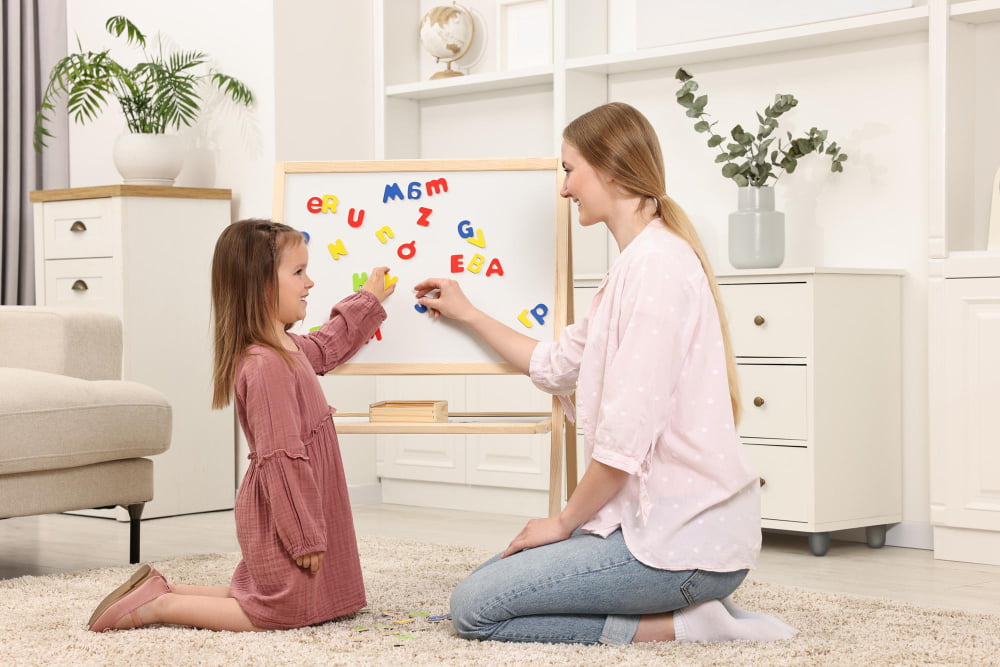Having children learn English from home is an option increasingly valued by families looking for flexibility and closeness in their children’s education. It’s not just about teaching a language, but about creating a daily environment where English becomes a natural part of everyday life. In this article from FunTalk, you’ll discover how to learn English at home alongside your children, promoting the language in a practical and fun way, without needing to leave the house.
1. Create a bilingual environment at home
The first step for your children to learn English is to surround them with the language constantly. You can play English music, watch cartoons or movies suitable for their age, and read children’s books in English. These resources will help their ears get used to the sounds and basic structures of the language.
Also, try to incorporate English in simple daily conversations. For example, greet them in English in the morning (“Good morning”), name household objects in English (“Look, this is a chair”), or say short phrases during routines (“Let’s brush our teeth”).
2. Use games and playful activities
Learning through play is undoubtedly the best way for children to learn English. Through play, they feel motivated, participate actively, and retain vocabulary better. You can use memory card games with images and words in English, do crafts following instructions in English, or use educational apps designed for children’s learning.
Another idea is to sing English songs for kids. Rhymes and melodies facilitate memorization and repetition of vocabulary. Songs like “The Alphabet Song” or “Head, Shoulders, Knees and Toes” are perfect for the little ones.
3. Establish a daily learning routine
Consistency is fundamental for effective learning. Dedicate at least 15-20 minutes daily to English activities. It doesn’t have to be a formal class; it can simply be reading a story, playing a game, or watching a short video.
It’s recommended to set a fixed schedule, for example, just before snack time or after homework, so children know that this time is meant for practicing English. This also helps create a habit that will last over time.

4. Be a role model and participate actively
Children learn a lot by watching their parents. That’s why it’s important that you also show interest in English. If you’re not very fluent, don’t worry; attitude and motivation are what really matter.
You can learn alongside them, look up new words, practice phrases, and celebrate every small achievement. This will give them confidence and enthusiasm to keep learning.
5. Take advantage of new technologies
Nowadays, there are numerous platforms, apps, and online resources designed to teach English to children. Tools like Duolingo Kids, Lingokids, or ABCmouse offer interactive lessons adapted to different ages and levels.
You can also find educational videos on YouTube, online games, and digital books that complement teaching at home. Just be sure to supervise screen time to maintain a healthy balance.
6. Introduce vocabulary related to their interests
To capture children’s interest, it’s key that learning is related to their favorite hobbies and activities. If they like animals, focus on learning vocabulary about pets, wild animals, or farm animals.
If they are soccer fans, you can teach words related to the sport, team names, or cheering phrases. This makes learning more meaningful and fun.
7. Don’t be afraid of making mistakes
Learning a language involves making mistakes, and children know this well. What’s important is creating an environment where they feel comfortable practicing without fear of failure. Correct gently and encourage them to try expressing themselves freely.
Confidence is essential so they don’t lose motivation and continue progressing.
8. Seek opportunities to practice with native speakers
If possible, allow your children to interact with native English speakers. This can be through online classes, language exchanges, or community meetups.
These experiences enrich learning and improve listening comprehension and pronunciation.
In short, teaching your children English from home is possible if you integrate the language naturally, fun, and consistently into their daily life. You don’t need to be an expert or dedicate endless hours: with patience, creativity, and dedication, your children can develop a solid foundation in English that will greatly help them in the future.
Want to start today? Try a song in English or a little chat, and you’ll see how little by little the language becomes part of your daily routine.
